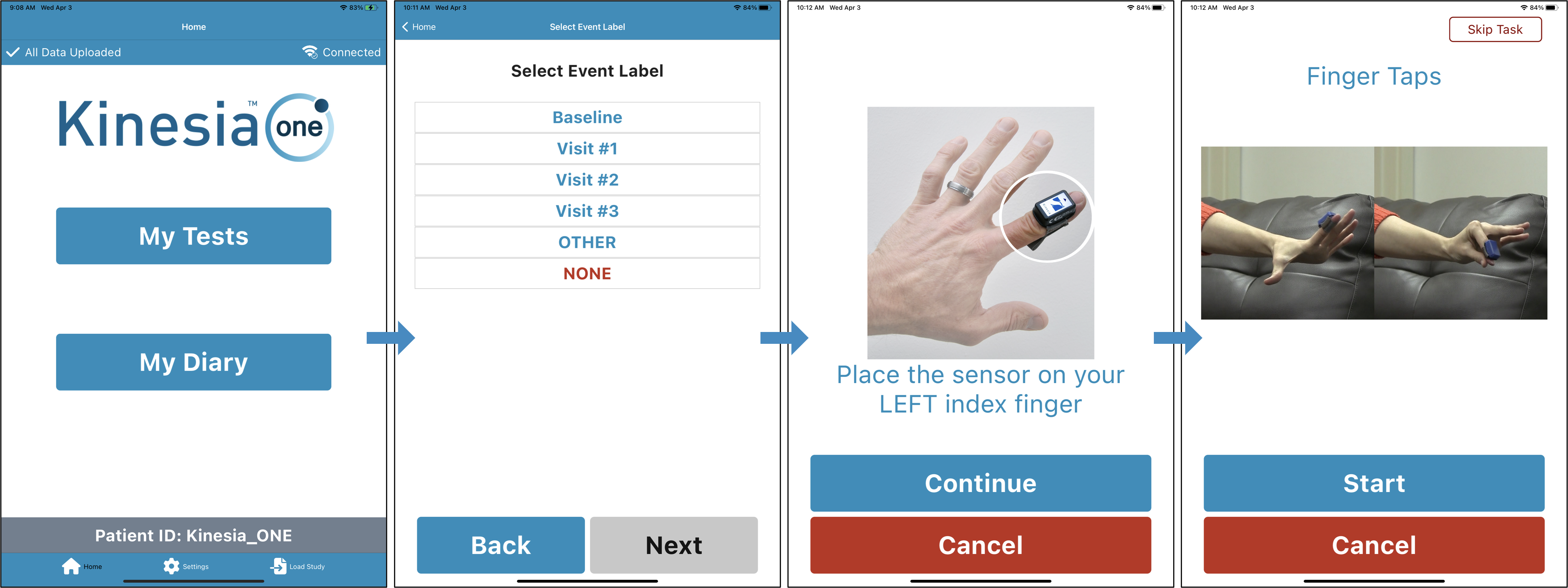The Kinesia ONE™ motor assessment system provides highly sensitive motor symptom assessment by having the patient perform brief pre-defined tasks based on common rating scales (e.g., UPDRS, TETRAS). A mobile application guides patients through donning the motion sensor on their finger or heel and provides intuitive instructions for completing the assessment tasks. Data from the motion sensor is uploaded to the Kinesia Web Portal in real-time and algorithms are used to calculate severity scores on a 0-4 rating scale shown to be highly correlated with clinician ratings.
Kinesia ONE
Task-Based Motor Assessments
Clinically validated outcome for in clinic and at home
Measure with high sensitivity and reliability
Real-time remote data analysis, management, and reporting
For Parkinson’s Disease and Essential Tremor
The Kinesia ONE™ motor assessment system provides highly sensitive motor symptom assessment by having the patient perform brief pre-defined tasks based on common rating scales (e.g., UPDRS, TETRAS). A mobile application guides the patient through donning the motion sensor on their finger or heel, and provides intuitive instructions for completing the assessment tasks. Data from the motion sensor is uploaded to the Kinesia Web Portal in real-time and algorithms are used to calculate severity scores on a 0-4 rating scale shown to be highly correlated with clinician ratings.

Kinesia ONE Tasks and Outcome Measures
| Task | Outcome Measure(s) |
| Arms resting | Resting tremor, dyskinesia |
| Arm(s) extended | Postural tremor, dyskinesia |
| Wing-beating posture | Postural tremor |
| Finger-to-nose | Kinetic tremor |
| Finger-chin-finger | Kinetic tremor |
| Finger-tapping | Bradykinesia (speed, amplitude, and rhythm) |
| Hand-grasping | Bradykinesia (speed, amplitude, and rhythm) |
| Pronation-supination | Bradykinesia (speed, amplitude, and rhythm) |
| Toe-tapping | Bradykinesia |
| Leg lifts | Leg agility |
| Walking and turning | Gait, freezing of gait |
Validated Reliable Real-time Secure
The Sensor
The Kinesia ONE sensor is worn on the finger during specific tasks used to assess symptoms. The sensor transmits motion data wirelessly to the tablet using a Bluetooth radio. (The Sensor includes a triaxial accelerometer, triaxial gyroscope, Bluetooth radio and wireless recharging).
Kinesia ONE Tablet Software
The tablet is preloaded with the Kinesia ONE software and instructs patients on how to perform each assessment. Great Lakes NeuroTechnologies also provides mobile device management to ensure software is always current and controlled. Kinesia ONE software has been translated into English, Spanish, French, German, and Swedish and may be translated into additional languages upon request.
Secure Web Portal
Once an assessment has been completed, motion data is transmitted from the tablet to the cloud via mobile broadband or Wi-Fi to a cloud database that complies with 21 CFR Part 11. Clinicians and researchers access their data and reports real-time by logging into the Kinesia web portal.
Kinesia ONE Reports
The Kinesia ONE reports provide objective motor scores each time an assessment is performed. Symptom scores ranging from 0 (no symptoms) to 4 (severe symptoms) are calculated by clinically validated algorithms shown to be highly correlated with expert clinical ratings. (Customized data reporting is available)
Click HERE for a complete list of clinical validation publications.
Kinesia™ products are used as outcome measures in Phase I, II, III and IV clinical trials.
Kinesia technology is integrated in clinical trials around the globe for Parkinson’s disease, essential tremor and other movement disorders. Intelligent remote sensing technology increases the sensitivity and reliability of outcome measures, improves efficiency with web applications and expands accessibility. To view publications, please click HERE
